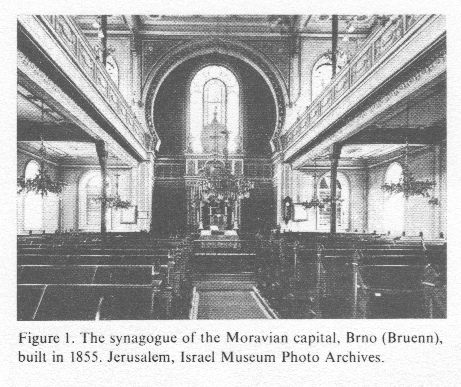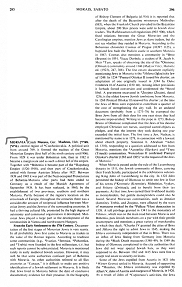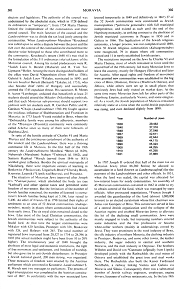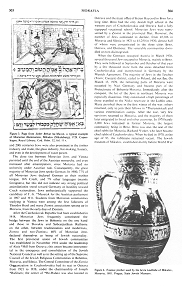[Territorial Developments]
MORAVIA (Czech Morava, Ger. Maehren), central region of
*Czechoslovakia.
A political unit from around 769, it formed the nucleus of
the Great Moravian Empire (first half of the ninth century
until 906). From 1029 it was under Bohemian rule, then in
1182 it became a margravate [[county]] and as such a direct
fief [[feudal tenure]] of the Great Moravian Empire (first
half of the ninth century until 906). From 1029 it was under
Bohemian rule, then in 1182 it became a margravate
[[county]] and as such a direct fief of the empire.
Together with *Bohemia it became part of the *Hapsburg
Empire (1526-1918), and then part of Czechoslovakia, united
with former Austrian Silesia after 1927. Between 1939 and
1945 it was part of the Nazi-occupied Protectorate of
Bohemia-Moravia after parts had been ceded to Germany as a
result of the Munich Agreement of September 1938. It has
been replaced, in 1960, by the establishment of two
provinces, southern and northern Moravia. Partly because of
the region's location on the crossroads of Europe,
throughout the centuries there was a considerable amount of
reciprocal influence between Moravian Jewry and the Jewries
of the surrounding countries.
It had a thriving cultural life, promoted by the high degree
of autonomy and communal organization it developed. Moravian
Jews played a large part in the development of the
communities in Vienna and northwestern Hungary.
From the Early Settlement
to the 17th Century. [Roman times - reports from the
Middle Ages]
Documentation of the first stages of Moravian Jewry is very
scanty [[little]]. In all probability Jews first came to
Moravia as traders in the wake of the Roman legions.
According to tradition some communities (e.g. *Ivanice,
*Jemnice, *Pohorelice, and *Trebic) were founded in the
first millennium, C.E. but such reports cannot be
substantiated. Moravia is mentioned rarely in early medieval
Jewish sources. However, it may well be that some
authorities confused part of Bohemia with Moravia.
As other authorities referred to all Slav countries as
"Canaan", it is difficult to make any positive
identification of a Jewish settlement in Moravia. It is
likely that Jews lived in Moravia before the date of
conclusive documentary evidence for their presence. In the
biography (col. 295)
of Bishop Clement of Bulgaria (d. 916) it is reported that
after the death of the Byzantine missionary Methodius (885),
when the Frankish Church prevailed in the Byzantine Empire,
about 200 Slav priests weer sold to Jewish slave traders.
The Raffelstaetten toll regulations (903-906), which fixed
relations between the Great Moravian and the Carolingian
empires, mention Jews as slave traders, but do not say
whether they resided in Moravia.
According to the Bohemian chronicler Cosmas of Prague
(1039?-1125), a baptized Jew built the Podivin castle in
southern Moravia in 1067; Cosmas also mentions a community
in *Brno (Bruenn) in 1091. *Isaac Dorbelo, a student of R.
Jacob b. Meir *Tam, speaks of observing the rite of the
*Olomouc (Olmuetz) community around 1146 (
Mahzor Vitry, Hurwitz
ed. (1923), 247, 388).
The first extant document explicitly mentioning Jews in
Moravia is the *Jihlava (Iglau) city law of 1249. In 1254
*Premysl Ottokar II issued his charter, an adaptation of one
originally issued in 1244 by Duke Frederick II of Austria
(1230-46). Among other provisions it forbade forced
conversion and condemned the *blood libel. A gravestone
excavated in **Znojmo (Znaim), dated 1256, is the oldest
known Jewish tombstone from Moravia.
In 1268 Premysl Ottokar II renewed his charter; at the time
the Jews of Brno were expected to contribute a quarter of
the cost of strengthening the city wall. In an undated
document (probably from c. 1273-78) he exempted the Brno
Jews from all their dues for one year since they had become
impoverished. Writing to the pope in 1273, Bishop Bruno of
Olomouc complained that the Jews of his diocese employed
Christian wet nurses, accepted sacred objects as pledges
[[commercial deposit]], and that the interest they took
during one year exceeded the initial loan.
The first time a Jews Nathan, is mentioned by name is in
1278, in connection with a lawsuit about church property.
Solomon b. Abraham *Adret (d. 1310), responding to a
question addressed to him from Moravia, mentions the
*Austerlitz (Slavkov) and *Trest (Triesch) communities.
Wenceslaus II confirmed Premysl Ottokar's charter (1283 and
1305) "at the request of the Jews of Moravia".
[Jews in Moravia since the
14th century: moneylenders, trade - immigration of German
Jewish refugees from Black Death expulsions]
When Moravia passed under the rule of the Luxembourg dynasty
in 1311, the Jewish community of Brno, carrying their Torah
Scrolls, participated in the celebration welcoming King John
of Luxembourg to the city. In 1322 John permitted the bishop
of Olomouc to settle one Jew in four of his towns (*Kromeriz
(Kremsier), Mohelnice, Vyskov, and Svitavy (Zwittau)), and
to benefit from their tax payments. At that time Jews earned
their livelihood mainly as moneylenders, but gentile
[[non-Jewish]] moneylenders could also be found.
Several Moravian communities, such as Jemnice (Jamnitz),
Trebic, and Znojmo, were affected by the wave of massacres
evoked by the *Pulkau *Host desecration in 1338. A toll
privilege granted in 1341 to the monastery of Vilimov, which
was on the main road between Moravia and Bohemia, puts
Jewish merchants on a par with their gentile counterparts
and mentions a great variety of merchandise in which they
dealt.
*Charles IV granted the cities of Brno and Jihlava the right
to admit Jews in 1345, making the Jihlava community
independent of that in Brno. There was an influx of Jews
fleeing from Germany into Moravia during the *Black Death
massacres (1348-49). In 1349 the bishop of Olomouc
complained to the city authorities that Jews did not wear
special Jewish hats, as they were supposed to do. Between
1362 and 1415 Jews were free to accept real estate as
security on loans.
[Austrian Jewish refugees -
ban from the "royal cities" 1454-1848 - settlements in
villages - Turkish wars]
Some of the Jews expelled from Austria in 1421 (the
*Wiener Gesera) settled
in Moravia. Accused of supporting the *Hussites, the Jihlava
community was expelled by Albert V, duke of Austria and
margrave [[count]] of Moravia, in 1426. As a result of John
of *Capistrano's activities, the Jews (col. 296)
were expelled from five of the six royal cities in 1454
(Jihlava, Brno, Olomouc, Znojmo, and Neustadt; the sixth
royal city, Uherske Hradiste, expelled the Jews in 1514).
The royal cities remained forbidden to them until after the
1848 revolution. The Jews who were expelled settled in the
villages. During the 16th century, when there was no central
power in Moravia ("in every castle a king"), the Jews were
settled in small towns and villages under the protection of
the local lords. The latter treated them well, not only
because of the part they played in the economic development
of their domains, which they shared initially with the
Anabaptist communes, but also because one of the lords
belonged to the Bohemian Brethren (see *Hussites) or were
humanists; many therefore believed in religious tolerance.
The importance of the Jews in the Moravian economic life (as
military purveyors and *Court Jews) increased because of the
constant threat to the Turkish wars. Since several Christian
sects lived side by side it became somewhat easier for the
Jews to pursue his own interests without interference.
[Thirty Years' War: Jews
take over "Christian" houses - heavy suffering - refugees
from the Chmielnicki massacres 1648 and from the expulsion
from Vienna 1670 - crafts, trade and markets]
When the Anabaptists were expelled (1622), and the country
became depopulated during the Thirty Years' War (1618-48),
the Jews took over new economic areas and were also
permitted to acquire houses formerly occupied by "heretics".
However, at the same time some communities suffered severely
during the war (e.g., Kromeriz and *Hodonin (Goeding)).
Moravia also absorbed refugees from Poland after the *
Chmielnicki
massacres (1648), among them scholars such as Gershon
*Ashkenazi, author of
Avodat
ha-Gershuni, and Shabbetai Kohen, author of
Siftei Kohen, the
renowned commentary on the Shulhan Arukh, who became rabbi
of Holesov. Many Jews also arrived after the expulsion from
Vienna (1670).
At this time an increasing number of Moravian Jews were
engaged in crafts, a process that had already begun in the
16th century, and the cloth and wool merchants and tailors,
who made goods to be sold at fairs, were laying the
foundations of the textile and clothing industry for which
Moravia was later known. In 1629 *Ferdinand II permitted the
Jews to attend markets and fairs in the royal cities, on
payment of a special body tax (
Leibmaut; see
*Leibzoll); in spite of protests from the
guilds and merchants, the charter was renewed in 1657, 1658,
and 1723. Jews also attended fairs outside Moravia,
especially those in *Krems, *Linz, *Breslau (Wroczlaw), and
*Leipzig.
In 1650 the Moravian Diet decided that Jews might reside
only where they had been living before 1618, but the
decision was not enforced. Later this was modified by the
Diet of 1681 to permit Jews to dwell where they lived before
1657.
The Modern Era.
[anti-Jewish fine decrees and trade decrees by Charles VI
- separation laws]
On July 31, 1725, during the reign of Charles VI, an
imperial order fixed the number of registered (col. 299)
Jewish families at 5,106 and threatened any locality which
accepted Jews where they had not been previously settled
with a fine of 1,000 ducats.
On September 20 of that year the same penalty was imposed on
anyone who allowed Jews to come into possession of real
estate, particularly customhouses, mills, wool-shearing
sheds, and breweries. The first enactment was reinforced a
year later by allowing only one son in a family to marry
(see *Familiants Law); the second was never carried out as
it would have deprived noblemen of lucrative revenue and
most Jews of their livelihood. Under Charles VI the
geographical separation of the Jews was implemented in most
Moravian towns.
[Maria Theresa laws]
*Maria Theresa threatened Moravian Jewry with expulsion
(Jan. 2, 1745) but rescinded [[withdraw]] her order,
permitting them to remain for another ten years. In 1748,
however, she raised their toleration tax (
Schutzgeld) from a
total of 8,000 florins (since 1723) to 87,700 for the next
five years and 76,700 in the following five; in 1752 the tax
was fixed at 90,000 florins. Two years later the empress'
definitive "General Police Law and Commercial Regulations
for the Jewry of the Margravate of Moravia " appeared; as
its name indicates it regulated all legal, religious, and
commercial aspects of Jewish life in Moravia. The authority
of the
*Landesrabbiner
[["chief rabbi"]] was defined and his election regulated, as
were those of the other offices of the
*Landesjudenschaft.
[["Jewry of the county"]].
[The council of Moravian
Jewry: the "heads", the chief rabbi at Mikulov - two
different councils]
In essence the law was based on a translation by Aloys von
*Sonnenfels of the resolutions and ordinances of the old
Council of Moravian Jewry. Although the earlies recorded
session of the council had taken place in 1651, it was at
least a century older, for a Bendit Axelrod Levi was
mentioned in 1519 as being "head of all Moravian
communities". The names of most Moravian rabbis were
recorded from the mid-16th century.
A clearer picture of the council emerges after the Thirty
Years' War (1618-48): Moravia (
medinah) was divided into three provinces
(
galil), in each of
which two heads (
rashei
galil) officiated; at the same time, each one was a
member of the governing body of Moravian Jewry (
rashei ha-medinah). The
chief authority was the
Landesrabbiner
(rav medinah) [["chief rabbi"]] who had
jurisdiction over both secular and religious matters. His
seat was in *Mikulov (Nikolsburg). His presence at council
sessions was obligatory and he was the authoritative
interpreter of their decisions.
There were two types of council: the governing "small"
council of six heads of provinces, and the "large"
legislative one, which was attended by representatives of
the communities and met every three years at a different
community. The franchise was very limited and the
council oligarchic in spirit and practice. The last "large"
council, that of 1748, was attended by 61 representatives
elected by 367 houseowners. Its main function was the
election of small bodies of (col. 300)
electors and legislators. The authority of the council was
undermined by the absolutist state, which in 1728 defined
its ordinances as "temporary";
[The limitation of
independence of Jewish communities under Maria Theresa
since 1754 - further chief rabbis - schools - spiritual
metropolis of Nikolsburg and other schooling centers]
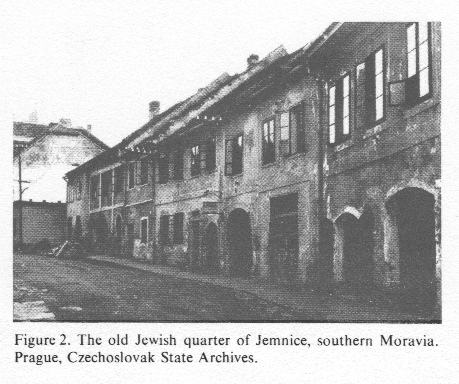
Encyclopaedia Judaica (1971): Moravia, vol. 12, col. 300,
the old Jewish quarter in Jemnice, southern Moravia
from 1754 Maria Theresa limited the independence of the
communities and their central council. The main function of
the council and the
Landesrabbiner
was to divide the tax load justly among the communities.
When
Landesrabbiner Menahem
*Krochmal was called upon to settle a dispute between the
poor and the rich over the control of the communities he
claimed that the decisive voice belonged to those who
contributed more to the community. Krochmal's tenure
(1648-61) was vital in the formulation of the 311 ordinances
(
shai takkanot) of
the Moravian council. Among his noted predecessors were R.
*Judah Loew b. Bezalel (Maharal) and R. Yom Tov Lipmann
*Heller. Among the more distinguished holders of the office
were David *Oppenheim (from 1690 to 1704); Gabriel b. Judah
Loew *Eskeles, nominated in 1690; and his son Issachar
Berush (Bernard) *Eskeles, (d. 1753), who also became chief
rabbi of Hungary and successfully averted [[stopped]] the
1745 expulsion threat.
His successor, R. Moses b. Aaron *Lemberger, ordained that
henceforth at least 25 students should attend the Mikulov
(Nikolsburg) yeshivah [[religious Torah school]], and that
each Moravian sub-province should support two yeshivot with
ten students each. R. Gershon Pullitz and R. Gershon *Chajes
(
Landesrabbiner
1780-89) fought against the insidious influence of
Shabbateanism and Frankism in Moravia: in 1773 Jacob *Frank
resided in Brno, where the *Dobruschka family were among his
adherents; members of the *Prostejov (Prossnitz) community
were commonly called
Schebse
since so many of them were followers of Shabbetai
Zevi.
In spite of the hostile attitude of Charles VI and Maria
Theresa and the continuous curtailment of the authority of
the council and the
Landesrabbiner,
there was a thriving communal life in Moravia. In the first
half of the 19th century the
Landesrabbineren Mordecai *Benet (d.
1829), Nehemiah (Menahem) Nahum *Trebitsch (d. 1842), and
Samson Raphael *Hirsch (served from 1846 to 1851) wielded
[[had]] great influence. Besides the spiritual metropolis of
Nikolsburg, there were important centers of learning in
Boskowitz (*Boskovice), Ungarisch-Brod (*Uhersky Brod),
Kremsier, Leipnik (*Lipnik nad Becvou),and Prossnitz. (col.
301)
The restrictions imposed on the Jews by Charles VI and Maria
Theresa, most of which remained in force until the second
half of the 19th century, led many Moravian Jews to leave
the country, mainly for Hungary (Slovakia) and later for
Austria. (S.302)
[Toleranzpatent under
Joseph II - limited number of licensed Jewish families -
"royal cities" remain closed]
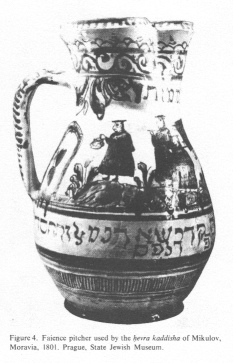

Encyclopaedia
Judaica
(1971): Moravia, vol. 12, col. 304, faience pitcher
used by the hevra kaddisha of Mikulov, Moravia, 1801
The situation of Moravian Jews improved after Joseph II's
*Toleranzpatent, which
abolished the body tax (see
*Leibzoll) and other special taxes and
permitted some freedom of movement. But the limitation of
the number of Jewish families remained, the number of
licensed (
systematisiert)
Jewish families being kept at 5,106, later raised to 5,400.
An edict of Francis II in 1798 limited their rights of
settlement to an area of 52 Jewish communities (
Judengemeinden), mostly
in places where communities had existed from early times.
The six royal cities remained closed to the Jews.
Like most of the local Christian communities, the Jewish
communities were subject to the authority of the feudal
lord. At that time the largest communities were Mikulov with
620 families, Prostejov with 328, Boskovice with 326, and
Hlesov with 265. The total number of registered Jews
increased from 20,327 in 1754 to 28,396 in 1803 (the actual
numbers might have been from 10 to 20% higher). (col. 301)
In 1787 Joseph II ordered that half of the main tax on
Moravian Jewry (then 88,280 florins) be allowed to
accumulate in a fund (known as
Landesmassafond) for the payment of the
Landesrabbiner [[chief
rabbi]] and other officials. (col. 302)
[[Napoleon 1800-1815 and his revolutionary legislations are
not mentioned]].
In 1831, when the fund was sealed, the capital was allocated
for low-interest loans for needy communities. (col. 302)
[1848: commercial
emancipation and anti-Jewish riots - self-defense units -
new municipal laws - new communities in the cities]
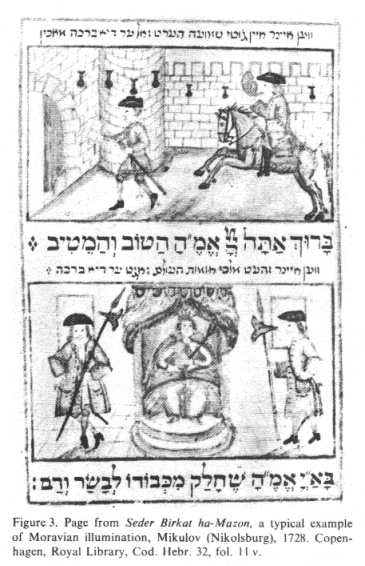
Encyclopaedia Judaica (1971): Moravia, vol. 12, col. 303,
illustration of 1728: Page from
Seder Birkat ha-Mazon, a typical example
of Moravian illumination, Mikulov (Nikolsburg), 1728
The revolutionary year of 1848 brought the abolition of most
legal and economic restrictions, the right of free movement
and settlement, and freedom of worship, but also gave rise
to anti-Jewish disturbances: in Prostejov a Jewish national
guard, 200 men strong, was organized. These measures of
freedom were enacted by the Austrian parliament which
convened in Kromeriz. Landesrabbiner [[chief rabbi]] S. R.
Hirsch sent two messages to parliament. The process of legal
emancipation was completed in the Austrian constitution of
1867.
In conformity with the new municipal laws (col. 301)
(passed temporarily in 1849 and definitively in 1867) 27 of
the 52 Jewish communities were constituted as Jewish
municipalities (
*politische
gemeinden) with full municipal independence, and
existed as such until the end of the Hapsburg monarchy, in
striking contrast to the abolition of Jewish municipal
autonomy in Prague in 1850 and in Galicia in 1866. The
legalization of the Jewish religious autonomy, a longer
process, was not completed until 1890, when 50 Jewish
religious communities (
Kultusgemeinden)
were recognized, 39 in places where old communities existed
and 11 in newly established Jewish centers. (col. 302)
After equal rights and freedom of movement were granted new
communities were established in the big cities of Brno
[[Bruenn]], Olomouc, Ostrava (Maehrisch Ostrau), and
Jihlava, while others were set up in small places that
previously Jews had only visited on market days. At the same
time many Moravian Jews left for other parts of the Hapsburg
Empire, particularly Vienna, and some emigrated. As a
result, the Jewish population of Moravia remained relatively
static at a time when the world Jewish population was
rising, and even declined slightly from 1890 [[probably
because of emigration waves]]. (col. 302)
Table:
Number of Jews in Moravia
|
Year
|
Number
of
Jews
|
1830
|
29,462
|
1840
|
37,316
|
1848
|
37,548
|
1857
|
42,611
|
1869
|
42,644
|
1880
|
44,175
|
1890
|
45,324
|
1900
|
44,255
|
1910
|
41,255
|
1921
|
37,989
|
from: Moravia; In: Encyclopaedia Judaica
(1971), vol. 12, col. 302
|
[The reorganization of the
fund (Landesmassafond) - professions in trade and
industries - Rothschild]
An assembly of 45 Moravian communities convened in 1862 in
order to try to obtain control of the fund
[[Landesmassafond]], which was managed by state officials.
After protracted negotiations, *Francis Joseph I awarded the
guardianship of the fund (almost 1,000,000 kronen) to an
elected curatorium whose first chairman was Julius von
Gomperz of Brno [[Bruenn]]. This curatorium served in lieu
of a central Jewish organization until the collapse of the
Austrian regime and enabled Moravian Jewry to alleviate
[[reduce]] the lot [[masses]] of the declining small
communities.
Jews were mainly engaged in trade, but increasing numbers
entered some industries and the free professions or became
white-collar workers (mainly in undertakings owned by Jews).
They were prominent in the wool industry of Brno, the silk
industry of northern Moravia, the clothing industry in
Prostejov, Boskovice, and some other towns, the leather
industry, the sugar industry in central and southern
Moravia, and the malt industry in Olomouc.
The brothers Wilhelm and David von *Gutmann (originally from
Lipnik) developed jointly with the Rothschilds the coal
mines of Ostrava and established the great iron and steel
works there. The Rothschilds also built the Kaiser Ferdinand
Nordbahn, a railway linking Vienna and Galicia via Moravia
and Silesia. Consequently there was a substantial number of
Jewish railway engineers, employees, engine drivers,
licensees of railway restaurants, etc.
In the late 19th (col. 302)
and 20th centuries Jews were also prominent in the timber
industry and trade, the glass industry, hat-making, hosiery,
and even in the development of water power.
[The link between Moravia
and Vienna - languages - racist Zionism movement in
Moravia]
The close ties between Moravian Jews and Vienna persisted
until the end of the Austrian monarchy, and even increased
after emancipation, since Moravia had no university under
Austrian rule. Consequently, the great majority of Moravian
Jews spoke German. In 1900, 77% of all Moravian Jews
declared German as their mother tongue, 16% Czech, and 7%
other languages (mainly foreigners), but this did not
indicate any strong political assimilationist trend toward
Germany or hostility toward Czech nationalism. Jews
enthusiastically supported the candidacy of T.G. *Masaryk
for the Austrian parliament in 1907 and 1911. Students from
Moravian communities studying in Vienna were among the first
followers of Theodor Herzl and many Zionist associations
sprang up in Moravia, from the early days of [[racist]]
Zionism.
[[The events during First World War 1914-1918 are missing in
this article]].
[1918-1938: Moravia in the
CSSR - expanding racist Zionist organizations]
After the Czechoslovak Republic had been established in
1918, Moravian Jews frequently constituted the bridge
between the Jews in Bohemia on the one hand and those in
Slovakia and Subcarpathian Ruthenia on the other, between
traditionalists and modernists, Zionist and non-Zionists;
60% of Moravian Jews declared themselves as being of Jewish
nationality. The first provincial union of Jewish
communities was established in November 1918 under the
leadership of Alois *Hilf from Ostrava; this union became
instrumental in the emergence and consolidation of the
Jewish National Council as well as in the setting up of the
Supreme Council of the Jewish Religious Communities in
Bohemia, Moravia, and Silesia. The Central Committee of the
Zionist Organization in Czechoslovakia had its seat in
Ostrava from 1921 to 1938, under the chairmanship of Joseph
*Rufeisen; the center of *He-Halutz was also located in
(col. 303)
Ostrava and the main office of Keren Hayesod in Brno for a
long time. Brno had the only Jewish high school in the
western part of Czechoslovakia and Ostrava had a fully
equipped vocational school. Moravian Jews were represented
by a Zionist in the provincial Diet. However, the number of
Jews continued to decline, from 45,306 in Moravia and
Silesia in 1921 to 41,250 in 1930 [[probably because of
emigration movement provoked by the racist Zionists]],
almost half of whom were concentrated in the three cities
Brno, Ostrava, and Olomouc. The venerable communities
dwindled or even disintegrated.
[NS occupations 1938-1945 -
holocaust]
When the Germans occupied Austria in March 1938, several
thousand Jews escaped to Moravia, mainly to Brno. They were
followed in September and October of that year by a few
thousand more from the areas detached from Czechoslovakia
and incorporated in Germany by the Munich Agreement. The
majority of Jews in the Teschen (Tesin; Cieszyn) district,
ceded to Poland, did not flee.
On March 15, 1939, the remaining parts of Moravia were
occupied by Nazi Germany and became part of the Protectorate
of Bohemia-Moravia. Immediately after the conquest, the lot
of the Jews in northeast Moravia was especially disastrous.
They constituted a high percentage of those expelled to the
Nisko reserve in the Lublin area. Many perished there in the
first winter of the war; others returned, only to join their
fellows in *Theresienstadt and various extermination camps.
(col. 304)
For fuller details on the holocaust period see *Protectorate
of Bohemia-Moravia. (col. 305)
[1945-1971]
After the war, very few survivors returned to Moravia, and
the majority of them later emigrated to Israel and other
countries.
[[The mass flight after 1945 to the DP camps and the
emigration wave to racist Herzl Israel and other oversea
countries is not mentioned. The communist reign since 1948
and the heavy anti-Semitism under the communist regimes as a
general punishment for the foundation of racist Zionist Free
Mason CIA Herzl Israel is not mentioned. By this the
remaining Jewish youth was lead for integration, mixed
marriages and change of religion and the number of Jews in
Moravia was more and more reduced. There were also some
emigrations permits, see: *
Czechoslovakia
1945-1971 ]].
In 1970 barely 2,000 Jews remained in former Moravia, the
largest community being in Brno [[Bruenn]]. Brno was also
the seat of the chief rabbi for Moravia, Richard *Feder, who
later became chief rabbi of Czechoslovakia. When he died in
1970, at the age of 95, the rabbinate remained vacant. The
Jewish museum of Mikulov, established shortly before World
War (col. 304)
II, was reconstituted as part of the state museum; another
Jewish museum was established by the state in Holesov.
For fuller details on the contemporary period see
*Czechoslovakia. [...] (col.305)
Table: List of alternative
names for places shown on map


Encyclopaedia Judaica (1971): Moravia, vol. 12, col. 304, faience pitcher
